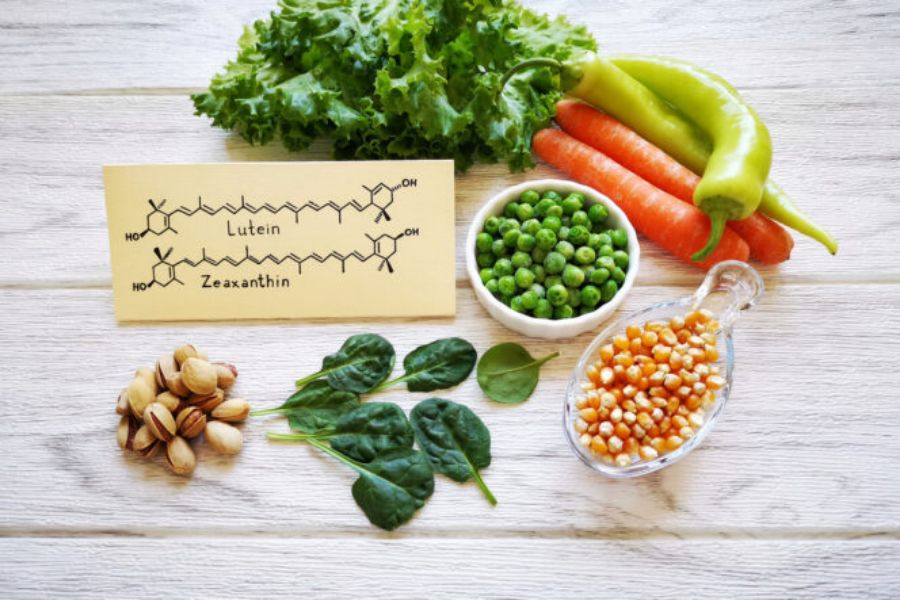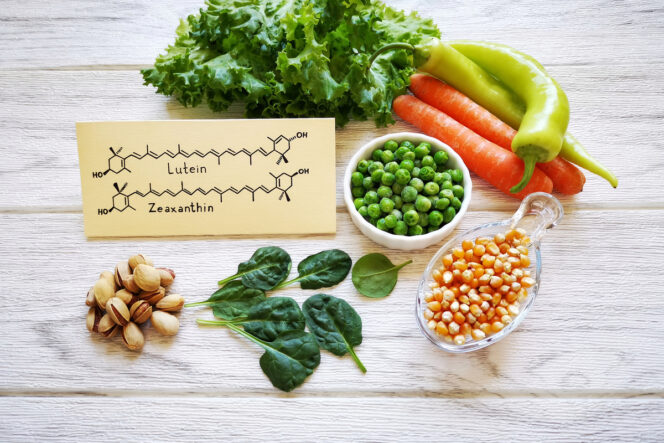
by Nutritionist Beatrice
The retina is a thin layer of light-sensitive nerve tissue that lines the back of the eyeball wall and it is the initial site of vision formation. When light enters the eye, it passes through the iris to the retina where the images are focused and converted electrical signals that are carried by optic nerve to the brain for visual recognition.
Blue light, a part of the visible light spectrum with the shortest wavelength and highest energy is naturally emitted from the sun and found artificially from electronic devices include computer screens and smartphones, as well as energy-efficient fluorescent bulbs and LED lights. This high-energy visible (HEV) light can penetrate though the cornea and lens to the retina causing vision problems such as age-related macular degeneration (AMD) and cataract. Prolonged exposure to blue light from digital screens can lead to eye strain, dry eyes, blurred vision and headaches. The use of blue light-emitting electronic devices before bedtime may affect sleep quality or exacerbate sleep disorders by inhibiting the production of melatonin, the hormone that controls the body’s sleep-wake cycle.

Macular degeneration or age-related macular degeneration (AMD) is an eye disorder associated with aging and causes blurred or reduced central vision due to thinning of the macula in the central part of retina. Central vision allows people to see detailed objects clearly and is essential for daily tasks such as driving and reading. There are two forms of AMD—wet (neovascular and exudative) and dry (atopic). Dry AMD affects approximately 80-90% of people with AMD and is characterized by small white or yellowish deposits, called drusen that form on the retina, beneath the macula, causing it to deteriorate or degenerate over time. Wet AMD accounts for 10-20% of all cases but it is a more visually threatening condition that contributes to most of the vision loss in AMD. Wed AMD develops when abnormal blood vessels grow underneath the retina. These blood vessels may leak fluids or blood, which can scar the macula.

The xanthophylls lutein, zeaxanthin and meso-zeaxanthin (derived from lutein) are the predominant carotenoids present in the macula lutea of human retina, providing the macula with its yellow appearance. These macular pigment carotenoids cannot be synthesised and must be obtained from dietary sources. Macular pigments efficiently absorb blue light and act as antioxidants to protect retinal cells from light-induced oxidative damage, which could lead to AMD.
Macula Pigment Optical Density (MPOD) is a measure of the eye’s ability to filter short-wave light. It is important to assess the risk for AMD and certain vision function deficits such as reduced contrast sensitivity, increased glare sensitivity and reduced photostress recovery time. Studies have shown that supplemental lutein and zeaxanthin increase MPOD, thereby enhancing visual performance, as well as improving sleep quality, eye strain, eye fatigue and headache frequency due to prolonged use of electronic devices1,2,3.
As in the neural retina, lutein and zeaxanthin are detected in human brain tissue at significantly higher concentrations than other carotenoids. MPOD relates to measures of global cognitive functioning and executive functioning in older adults4. Supplementation with lutein and zeaxanthin improved cognitive function in community dwelling older adults5. A recent study demonstrated children with greater MPOD values had better performance on academic measures, specifically in math and written language6.
References:
- Lisa M Wilson, Saraniya Tharmarajah, Yuanxi Jia, Richard D Semba, Debra A Schaumberg, Karen A Robinson, The Effect of Lutein/Zeaxanthin Intake on Human Macular Pigment Optical Density: A Systematic Review and Meta-Analysis, Advances in Nutrition, Volume 12, Issue 6, November 2021, Pages 2244–2254, https://doi.org/10.1093/advances/nmab071
- Yang-Mu Huang, Hong-Liang Dou, Fei-Fei Huang, Xian-Rong Xu, Zhi-Yong Zou, Xiao-Ming Lin, "Effect of Supplemental Lutein and Zeaxanthin on Serum, Macular Pigmentation, and Visual Performance in Patients with Early Age-Related Macular Degeneration", BioMed Research International, vol. 2015, Article ID 564738, 8 pages, 2015. https://doi.org/10.1155/2015/564738
- Stringham JM, Stringham NT, O'Brien KJ. Macular Carotenoid Supplementation Improves Visual Performance, Sleep Quality, and Adverse Physical Symptoms in Those with High Screen Time Exposure. Foods. 2017 Jun 29;6(7):47. doi: 10.3390/foods6070047. PMID: 28661438; PMCID: PMC5532554.
- Feeney J, Finucane C, Savva GM, Cronin H, Beatty S, Nolan JM, Kenny RA. Low macular pigment optical density is associated with lower cognitive performance in a large, population-based sample of older adults. Neurobiol Aging. 2013 Nov;34(11):2449-56. doi: 10.1016/j.neurobiolaging.2013.05.007. Epub 2013 Jun 12. PMID: 23769396.
- Hammond BR Jr, Miller LS, Bello MO, Lindbergh CA, Mewborn C, Renzi-Hammond LM. Effects of Lutein/Zeaxanthin Supplementation on the Cognitive Function of Community Dwelling Older Adults: A Randomized, Double-Masked, Placebo-Controlled Trial. Front Aging Neurosci. 2017 Aug 3;9:254. doi: 10.3389/fnagi.2017.00254. PMID: 28824416; PMCID: PMC5540884.
- Barnett SM, Khan NA, Walk AM, Raine LB, Moulton C, Cohen NJ, Kramer AF, Hammond BR Jr, Renzi-Hammond L, Hillman CH. Macular pigment optical density is positively associated with academic performance among preadolescent children. Nutr Neurosci. 2018 Nov;21(9):632-640. doi: 10.1080/1028415X.2017.1329976. Epub 2017 May 23. PMID: 28535707; PMCID: PMC6251725.

